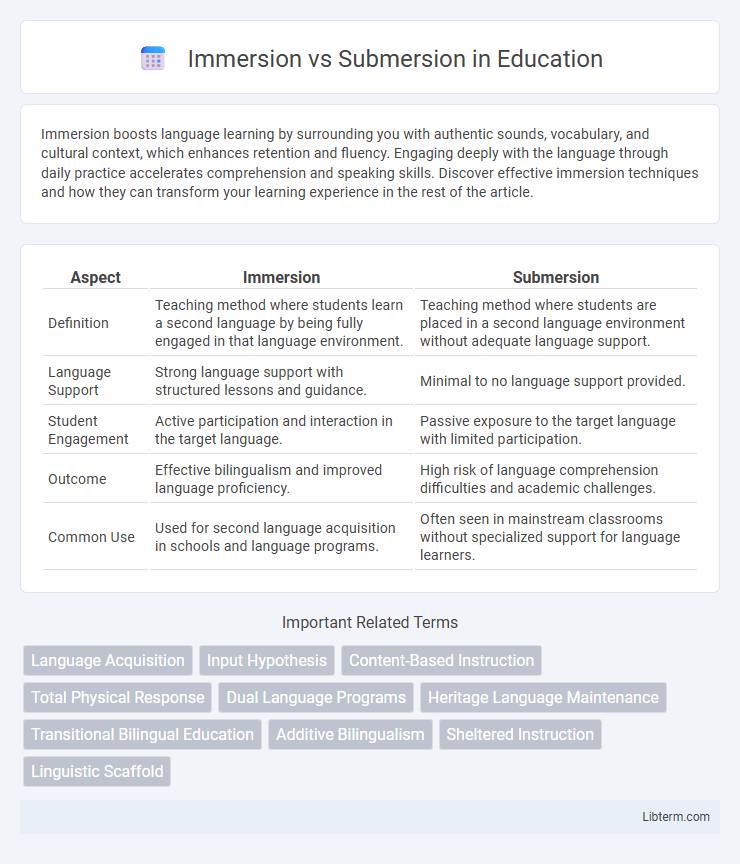Immersion boosts language learning by surrounding you with authentic sounds, vocabulary, and cultural context, which enhances retention and fluency. Engaging deeply with the language through daily practice accelerates comprehension and speaking skills. Discover effective immersion techniques and how they can transform your learning experience in the rest of the article.
Table of Comparison
| Aspect | Immersion | Submersion |
|---|---|---|
| Definition | Teaching method where students learn a second language by being fully engaged in that language environment. | Teaching method where students are placed in a second language environment without adequate language support. |
| Language Support | Strong language support with structured lessons and guidance. | Minimal to no language support provided. |
| Student Engagement | Active participation and interaction in the target language. | Passive exposure to the target language with limited participation. |
| Outcome | Effective bilingualism and improved language proficiency. | High risk of language comprehension difficulties and academic challenges. |
| Common Use | Used for second language acquisition in schools and language programs. | Often seen in mainstream classrooms without specialized support for language learners. |
Introduction to Language Learning Methods
Immersion and submersion represent distinct language learning methods with immersion involving structured, supportive environments where learners actively engage with the new language through meaningful communication and contextualized experiences. Submersion refers to placing learners in situations where only the target language is spoken without explicit support, often leading to passive exposure rather than active acquisition. Effective language education prioritizes immersion techniques to enhance comprehension, speaking skills, and cultural understanding for more successful language acquisition outcomes.
Defining Immersion in Language Acquisition
Immersion in language acquisition involves surrounding learners with the target language in various contexts to promote natural and intuitive understanding. This method emphasizes active participation and communication, allowing learners to absorb vocabulary, grammar, and pronunciation through meaningful interaction. Immersion creates an environment where the second language becomes the primary mode of communication, fostering quicker fluency and cultural competence.
What is Submersion?
Submersion refers to the process of fully placing an object or material beneath a liquid, often water, to achieve total coverage and interaction with the liquid environment. In educational contexts, submersion describes learners being placed directly into a foreign language environment without explicit instruction, facilitating natural language acquisition through immersion. This technique contrasts with partial exposure methods and is effective in promoting rapid language fluency and cultural integration.
Key Differences Between Immersion and Submersion
Immersion involves placing an object partially in a fluid, typically with some portion remaining above the surface, while submersion means the object is completely enveloped by the fluid. Immersion often relates to processes like cleaning or testing limited exposure effects, whereas submersion is crucial for applications requiring total fluid contact, such as underwater robotics or biological experiments. The key difference lies in the extent of fluid contact, influencing factors like pressure, buoyancy, and material interaction.
Advantages of Immersion Programs
Immersion programs offer superior language acquisition by surrounding learners with the target language in real-life contexts, enhancing fluency and comprehension more effectively than traditional methods. Students in immersion settings demonstrate improved cognitive flexibility, cultural awareness, and long-term retention of vocabulary and grammar. Research shows immersion learners often outperform peers in standardized language proficiency tests and exhibit greater adaptability in multilingual environments.
Challenges of Submersion Environments
Submersion environments present significant challenges such as extreme pressure variations that affect both equipment integrity and human physiology. Limited visibility and restricted mobility increase the risk of disorientation and accidents during underwater tasks. Furthermore, maintaining communication and reliable life support systems underwater complicates operational safety and efficiency.
Effectiveness for Language Fluency
Immersion environments significantly boost language fluency by surrounding learners with native speakers and authentic contexts, promoting natural language acquisition and cultural understanding. Submersion, while also placing learners in a target language setting, may lead to initial confusion and frustration without adequate support, potentially hindering progress. Research indicates that structured immersion programs with scaffolding and communicative opportunities result in faster, more sustainable fluency development compared to unstructured submersion experiences.
Psychological Impacts on Learners
Immersion in language learning fosters deep cognitive engagement by surrounding learners with the target language, enhancing neural pathways associated with language acquisition and promoting stronger retention. Submersion, often characterized by learners being placed in a target-language environment without adequate support, can lead to increased anxiety, stress levels, and feelings of isolation, negatively impacting motivation and psychological well-being. Research highlights that immersion programs facilitate better emotional adjustment and confidence, while submersion may cause cognitive overload and hinder learners' overall language development.
Real-World Examples and Case Studies
Immersion therapy has been effectively utilized in treating phobias, such as systematic desensitization for arachnophobia by exposing patients gradually to spiders in controlled environments. Submersion techniques are prominently applied in language acquisition, exemplified by Canadian French immersion programs where students are fully submerged in French-only classrooms to achieve bilingual proficiency. Case studies from virtual reality training in aviation reveal that immersion enhances pilots' situational awareness by replicating real-world cockpit conditions, whereas submersion models in underwater welding training emphasize skill acquisition through complete exposure to relevant environmental factors.
Choosing the Best Approach for Learners
Choosing between immersion and submersion methods depends on learners' language proficiency and learning goals. Immersion provides complete exposure to the target language in natural contexts, enhancing fluency and cultural understanding. Submersion places learners in mainstream environments without tailored support, which may hinder comprehension but can foster rapid adaptation through necessity.
Immersion Infographic

 libterm.com
libterm.com